A Song of Spice and Fire: The Real Deal With Hunan Cuisine
While the Hunanese were China's early chile adopters, there's more to this cuisine than lashings of heat.
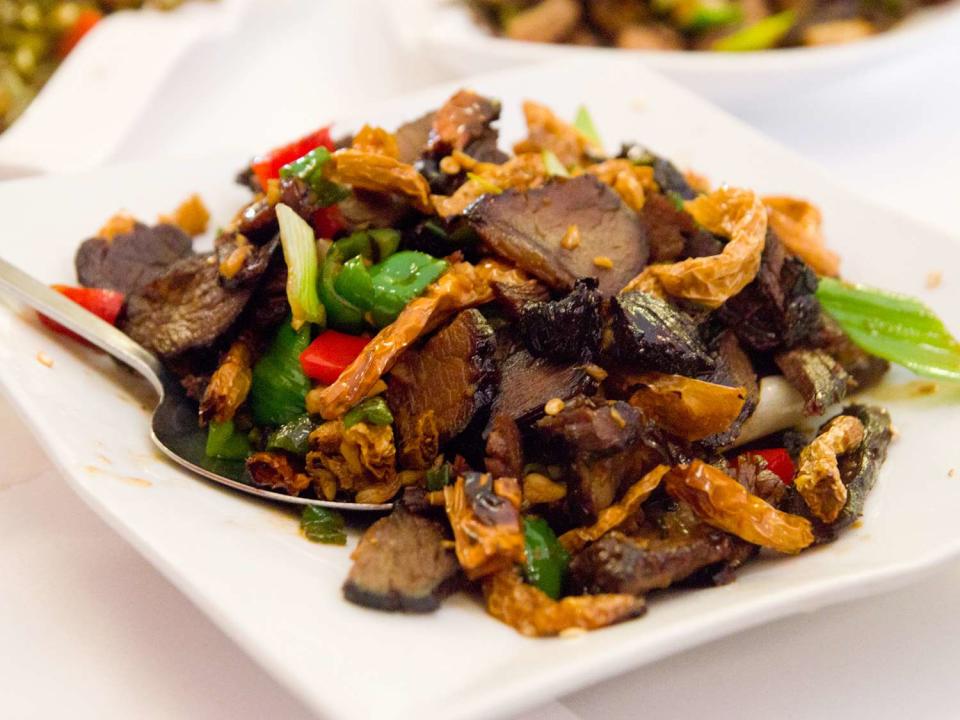
Serious Eats / Max Falkowitz
Smoked beef with crisp dried chiles—Hunan cooking is all about spicy, savory flavors.Chairman Mao Zedong, who hailed from spice-loving Hunan province, once said, "You can't be a revolutionary if you don't eat chiles." The Hunanese food writer Liu Guochu says Mao loved spice so much he sprinkled ground chiles on slices of watermelon.
My first experience with anything vaguely resembling the cuisine of Hunan was at a Levittown strip mall, and the Chairman would not have found it very revolutionary. In 1970s Long Island, Hunam Restaurant's spicy cold noodles and hacked chicken with sesame sauce were considered the height of regional Chinese cuisine. The only real chile presence at Hunam was the dish of "hot oil" that my old man would invariably ask for.
For many years even I thought the cuisine of Hunan was just a more incendiary version of Sichuan cuisine. Apparently I am not alone in this viewpoint, as the Chinese themselves are known to feel this way.
"The Sichuanese are not afraid of chile heat; No degree of hotness will afright [sic] the people of Guizhou, but those Hunanese are afraid of food that isn't hot," goes an old Chinese joke recounted by Fuchsia Dunlop in her Revolutionary Chinese Cookbook, which focuses on recipes from Hunan province.
But "in fact, Hunanese food is not necessarily hotter than the food of, say, Chongqing," Dunlop told me via e-mail. And there's much more to it than heat.
The Great Hunan Migration
When the chile first made its way to China from the New World, the Hunanese were one of its earliest adopters in the late 17th century. But Hunan food sets itself apart from Sichuanese in two big ways: It doesn't use the tongue-numbing Sichuan peppercorn, and savory dishes lack the sweetness of their Sichuan counterparts. "So while the Sichuanese have all kinds of spicy-sweet-savoury combinations," says Dunlop, "including the 'fish-fragrant' and 'garlic paste' flavors, the Hunanese tend to go for bold savory tastes, chile-hot tastes, and sour-hot tastes."
Us Americans are pretty confused about what Hunan food means and how it differs from other regional cuisines, even though "Hunan-style" restaurants in the U.S. date back to the 1970s.
This misperception has its roots in how Hunan (and Sichuan) food was introduced to the American public, according to Kian Lam Kho, the author of Chinese food blog Red Cook who is currently working on a cookbook of classic Chinese cooking techniques. During the 1940s, a group of Chinese chefs trained in Hunan and Sichuan cuisines fled to Taiwan after the Communist takeover of mainland China. Some of these chefs prospered in Taiwan, then sought opportunities in the U.S. during the 1970s, eventually bringing Hunan and Sichuan cuisines to New York.
From there, classic Hunan and Sichuan dishes adjusted to local tastes (read: sweeter and less spicy and complex), where they helped form a universal Americanized Chinese cuisine that was more about General Tso than Chairman Mao.
"Given the complex history and local specialty ingredients, Hunan cuisine is a lot more sophisticated than the pseudo-Sichuan flavor often found in the Chinese American takeout eateries," Kho notes. "It is truly worthwhile to seek out restaurants or cookbooks that offer more closely recognizable Hunan flavors in their menus or recipes. You would be amazed how different authentic Hunan cooking is from its confusing Hunan/Sichuan cousin."
The Hallmarks of Hunan Flavor
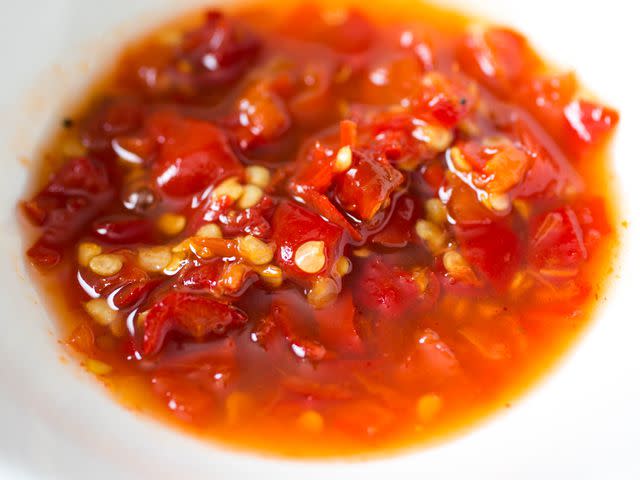
Serious Eats / Vicky Wasik
Hunan province takes its name from its geographical location, "south of the lake." Situated south of Dongting Lake, it shares borders with six other provinces, including Hubei to the north and Guangdong to the South. Celebrated local products include wild turtles, citrus, bamboo shoots, many types of fish, silver needle tea, lotus seeds, bacon, and, of course, chiles. Summers in the province's southern subtropical climate are hot and humid while winters are cool and damp, further bolstering the cuisine's predilection for the use of chiles, with the Chinese medicinal concept that chile heat expels unhealthy damp humors.
"Without chiles you can't eat rice," runs a popular Chinese adage. Chiles are a whole class of flavorings in Hunan, and different kinds are used in different ways.
Where Sichuanese cooks combine Sichuan peppercorns with chiles for the classic "numbing-hot" ma la flavor, the Hunanese prefer the sharp one-two punch of vinegar-pickled chiles with salt for something called duo la jiao. This hot, sour, and salty concoction is used as a relish for noodles and steamed fish heads, the latter of which Dunlop notes is currently one of the most popular Hunanese dishes.
Gan jiao mo, or chile flakes, are widely used as an all-purpose seasoning, while gan la jiao, small, pointy dried chiles, are cut lengthwise to release their flavor into broths. Fresh chiles add color and heat to steamed and stir fried dishes. And there are other varieties of pickled chiles, including long, green ones that turn pale green or yellow white after soaking in brine.
Here's an illustration of those chiles in action. One of the best Hunan dishes I've ever had comes from the excellent Hunan House in Flushing, Queens. It's called huang hui hong jiao chao niu rou, aka beef with crispy pepper, and it employs two kinds of chiles. The heap of stir fried beef is shot through with peanuts, pickled red chiles, garlic, and the star of the dish—hong jiao chao—the crispy red pepper. Crunchy, salty, and somehow lined on the inside with sesame seeds, these peppers are amazing. Meanwhile, the pickled chiles add a dose of freshness and funk, all without overwhelming the beef.
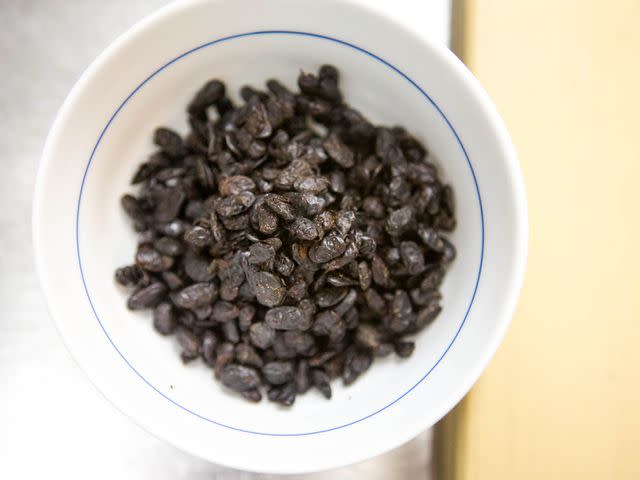
Serious Eats / Vicky Wasik
Fermented black soy beans.Beyond chiles, the Hunanese are masters of fermentation. Rural home cooks ferment tofu by covering it in dry rice straw and letting it mold for a few weeks. It is then mixed with strong liquor, salt, star anise, and chile flakes and packed into pickling jars for at least a month. The result is a cheesy-tasting, creamy substance (with an eye-watering aroma) used as a relish and an ingredient in sauces. Dou fu ru spread on toast is a favorite late-night nosh for Dunlop.
As in Cantonese cuisine, dou chi, or fermented black soy beans, are widely employed by cooks in Hunan. Cantonese cooks often mash them into a paste with garlic, but the Hunanese add them whole to dishes along with, you guessed it, chiles for a blend of rich, earthy savoriness and a kick of heat.
That's not the only stinky bean. La ba dou, winter sacrifice beans (aka yellow soybeans), get fermented and added to steamed and stir fried dishes. They're first cooked, then left out to mold, then sealed in crocks with salt, wine, and ginger until they develop a rich umami flavor. Dunlop recommends stir frying them with a little ground pork, sliced red chile, and a copious amount of coriander stems.
And then there's bacon. "Skin as richly red as amber, fat as luminous as crystal, lean meat like a rose," goes local historian Li Peitan's description of his homeland's celebrated preserved pork belly, la rou. In the Hunanese countryside, smoking bacon by a farmhouse kitchen fire remains a local tradition. It's also prevalent in the cities, where Dunlop says makeshift smokehouses are in found in the courtyards of apartment complexes. Bacon is used in many dishes such as xiang gan zi chao la rou, stir fried smoky bacon with smoked bean curd.
Hunan Dishes You Should Know
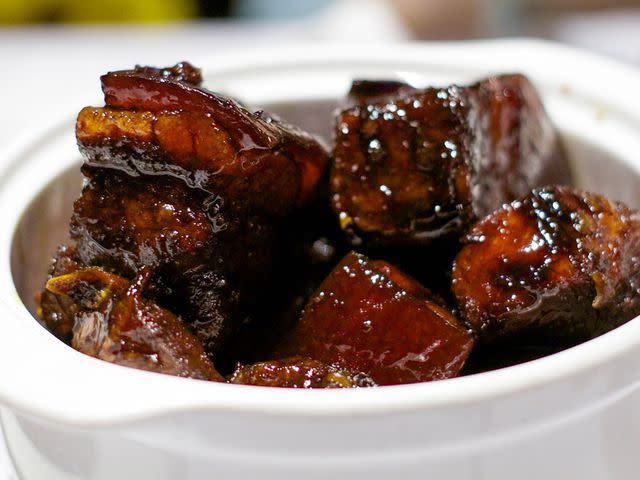
Mao shi hong shao rou (Chairman Mao's red-braised pork): This dish is so linked with Mao Zedong that today on menus in China and the U.S. alike it still bears his name. The Chairman is said to have loved the braised pork belly fragrant with star anise, ginger, chiles, and cassia bark so much he insisted his Hunanese chefs prepare it for him in Beijing. "Men eat it to build their brains," Chairman Mao's nephew, Mao Anping, once told Dunlop.
Duo jiao zheng yu: Steamed fish heads covered in scarlet pickled chiles and pungent black beans were all the rage when Dunlop was living in Changsha. In Hunan the dish is made with bighead carp. In New York City it can be found at Hunan House and Hunan Kitchen of Grand Sichuan.
Tang cu pai gu (sweet and sour spare ribs): It might sound like an American takeout special, and sweet flavors have only a minor role in Hunanese cookery, but this dish of deep fried ribs coated in a thick sweet and vinegar-inflected sour sauce was a specialty of Xiaxiang Jiujia, a leading Changsha restaurant of the 1930s, and remains popular today.
La ba dou zheng la wei (steamed bacon and smoked bean curd with winter sacrifice beans): Hunanese cooks like to stack their preserved ingredients. Here strips of smoky bacon are stir fried with smoked tofu and those pungent yellow soy beans, then given a hit of heat with dried chile flakes.
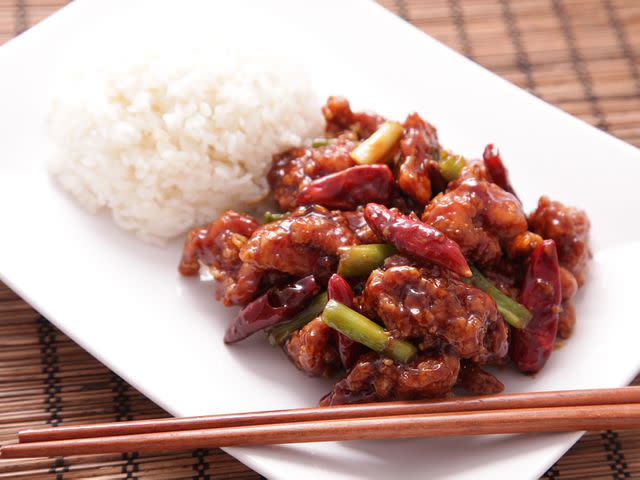
Serious Eats / J. Kenji Lopez-Alt
Dong an zi ji (Dong'an chicken): One of Hunan's most famous poultry dishes is this delicate creation of chicken flavored with chile and clear rice vinegar, which is said to have originated in Dong'an county. The story goes that it's based on a dish called cu ji, or vinegar chicken, served way back in the Tang dynasty. Its more modern legend is familiar to anyone who's heard the origin stories of nachos and Buffalo wings: Some merchants paid a visit to a restaurant run by three old ladies who've just run out of everything in the kitchen. So the ladies went out back, slaughtered some chickens, added in some pantry staples, and called it dinner. The merchants loved the dish and told everyone they knew about it, and thus it entered the Hunanese canon.
Duo jiao chao ya bai (stir fried Chinese leaf cabbage with chopped salted chiles): Stir fried Chinese cabbage leaves, dressed with toasty sesame and the ubiquitous pickled chiles, are a great way to round out a Hunanese feast.
Pai huang gua (smacked cucumbers): This refreshing and popular Hunanese appetizer of cold cucumbers dressed with garlic, dried chile flakes, and vinegar takes its name from whacking the cucumbers with the flat of cleaver, which encourages them to absorb the dressing.
General Tso's Chicken: This dish that's come to epitomize Chinese-American cookery was actually created by a Hunanese chef. Chef Peng Chang-Kuei, who was the presidential palace chef of the Nationalist Government, invented this dish in Taiwan during the 1950s.
He was cooking for the visiting admiral Arthur W. Radford, the chairman of the U.S. Joint Chiefs of Staff, who was in Taiwan for talks with President Chiang Kai-Shek. Asked to create a banquet to entertain the illustrious guest, Peng planned some traditional dishes and created some new ones, including the now famous General Tso's chicken.
The original recipe as invented by Peng was much more tart, garlicky, and spicy than the cloyingly sweet version found at the corner takeout these days. For the record, my chile-loving old man was never a big fan of General Tso's. I bet he would have liked the O.G. version, though.

